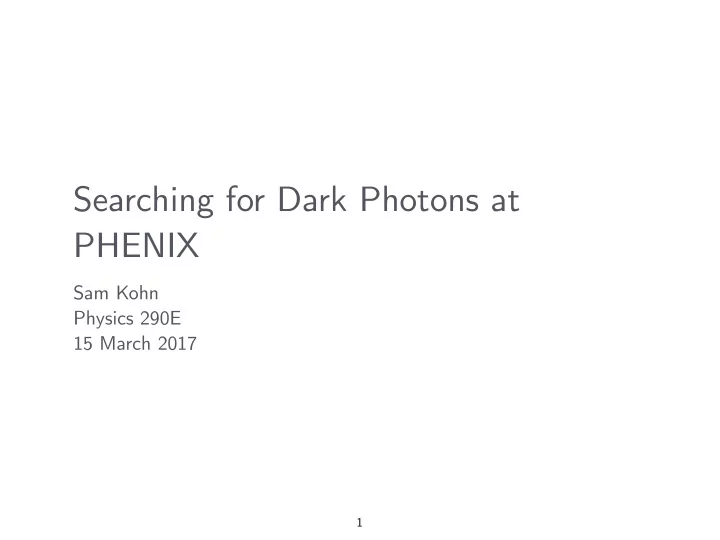

Searching for Dark Photons at PHENIX Sam Kohn Physics 290E 15 March 2017 1
What is a dark photon? e + Dark sector doesn’t interact (much) with SM particles U e – Dark photon U (or A ʹ ) q analogous to SM photon γ U Hypothesized mixing with γ in Lagrangian q γ � µ µ Source: [1] µ µ U 2 Source: Wikipedia
Muon anomalous magnetic moment A.k.a. g – 2 At tree level g = 2 � g – 2 provided by loops ⟹ gives insight into virtual particles E821 at Brookhaven found a 3.6 σ discrepancy from SM Source: [2] 3
Muon g – 2 experiment E821 magnet moved to Fermilab to use more intense beam Measure spin precession of muons in B fi eld Translate into magnetic moment using the Larmor precession formula Source: Fermilab 4
Possible causes for discrepancy Popular today Statistical fl uctuation SUSY Dark photon (sort of) Popular at some point (including possibly today?) Radiative mass generation New gauge bosons Anomalous W boson properties Source: [3] 5
Dark photon properties To resolve the g – 2 anomaly, the dark photon should mix with regular photons via something like have a mass ≳ 25 MeV to avoid ruining electron g – 2 have a coupling ε 2 ∼ 10 -6 -10 -5 for masses 25-100 MeV 6
How to search for dark photons Note: much lighter and much heavier dark photon models exist. Search methods are di ff erent. Your mileage may vary. If you have a dark photon, it could decay into particle- antiparticle pairs (via mixing with the photon) Find a situation where you know the decay energy spectrum well—and look for a bump (surprise surprise…) At PHENIX, that’s π 0 → γ U → γ e + e - (or the same with η ) 7
PHENIX detector At RHIC (Brookhaven) √ s NN = 200 GeV, p-p and d- Au collisions (3 data sets) Inner tracker to identify e ± candidates Cherenkov detector + EM-cal gives an energy-momentum criterion to accept e ± tracks γ just show up in EM-cal Source: https://www. fl ickr.com/photos/ brookhavenlab/3707885404 8
Predicted mass spectra Spectrum of invariant e + e – mass m ee for Dalitz decay ( π , η to γ e + e – ) calculable using Kroll-Wada formula � � Spectrum from Dark photon decay given by fi nite detector resolution (narrow width spectrum) 9
Detector e ff ects m ee resolution found using Monte Carlo: 3.1 ± 0.09 MeV (expected width of dark photon peak) e + e – pairs from in-detector conversion are rejected by kinematic cuts and by angle w.r.t. external magnetic fi eld This and others inform the correction to the predicted spectra: 10
More detector e ff ects New Hadron-Blind Detector increased γ → e + e – conversion rates in 2009 ⟹ increased background 11
Fit results 12
Update to exclusion plot Rules out most of the <100MeV dark photon parameter space. Small bit left between 29 and 32 MeV Note: BaBar excludes all the way out to 10 GeV 13
Conclusions Dark photons are hypothesized to help solve the muon g – 2 anomaly PHENIX (and others) looked for mass peaks in e + e – invariant mass from three-body decays of π and η No peaks were found, excluding dark photons from resolving the g – 2 anomaly at 90% CL on almost all of the parameter space examined 14
References [1] A. Adare et al . (PHENIX Collaboration), Phys. Rev. C 91 , 031901(R) (2015) [2] C. Patrignani et al . (Particle Data Group), Chin. Phys. C 40 , 100001 (2016) [3] A. Czarnecki and W. Marciano, Phys. Rev. D 64 , 013014 (2001) 15
Recommend
More recommend